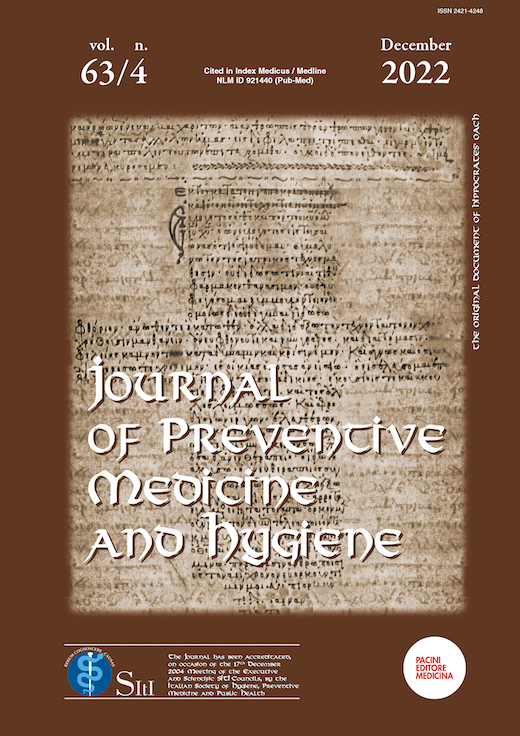Abstract
Objectives: Optimal regulation of modifiable risk factors, has been proposed as the standard of care, both for primary and secondary prevention of cardiovascular disease (CVD). The aim of this study was to investigate at what extent individuals who experienced an acute coronary syndrome (ACS) had previously been receiving adequate preventive measures against classical risk factors for CVD.
Methods: Data were analyzed for all 185 hospitalized patients with a diagnosis of ACS in the Cardiology department of our hospital during an annual period (1/7/2019 until 30/6/2020). The study population was divided in two groups, primary and secondary prevention subgroups, according to previous medical history of CAD.
Results: The mean age of the participants was 65.5 ±12.2 years and most patients were male (81.6%). Fifty-seven patients (30.8%) had a history of diabetes mellitus (DM) and 97 (52.4%) had a history of dyslipidemia. Hypertension was present in 101 (54.6%) patients and coronary artery disease (CAD) in 51 (27.9%). In the secondary prevention group, the LDL-C was on target in only one third, while one out of 5 patients did not use statins. The use of antiplatelet/anticoagulant agents was 94.5%. Among patients with diabetes, only one out of five patients had been using a GLP-1 receptor agonist or/and an SGLT-2 inhibitor, while the HbA1c was on target in half of them. One quarter of the patients were active smokers.In the primary prevention group, the use of statins was overall low (25.8%) but more frequent in patients with diabetes and those without diabetes at very high-risk (47.1% and 32.1% respectively). Overall, the LDL-C was on target in less than one quarter of patients. The use of antiplatelet/anticoagulant agents was low (20.1%), but higher in those with diabetes (52.9%). In the diabetic group, HbA1c was on target in 61.8%. Active smoking was practiced by more than one third of the patients.
Conclusions: Our data show that in a substantial proportion of patients presenting with ACS, previous CVD prevention, both primary and secondary, fails to meet the current recommendations provided by scientific societies.
References
2. Bhatnagar, P., et al., Trends in the epidemiology of cardiovascular disease in the UK. 2016. 102(24): p. 1945-1952.
3. Visseren, F.L.J., et al., 2021 ESC Guidelines on cardiovascular disease prevention in clinical practice. Eur Heart J, 2021. 42(34): p. 3227-3337.
4. Gaede, P., et al., Effect of a multifactorial intervention on mortality in type 2 diabetes. N Engl J Med, 2008. 358(6): p. 580-91.
5. Bonner, C., et al., Clinical Validity, Understandability, and Actionability of Online Cardiovascular Disease Risk Calculators: Systematic Review. J Med Internet Res, 2018. 20(2): p. e29.
6. Conroy, R.M., et al., Estimation of ten-year risk of fatal cardiovascular disease in Europe: the SCORE project. Eur Heart J, 2003. 24(11): p. 987-1003.
7. World Medical, A., World Medical Association Declaration of Helsinki: ethical principles for medical research involving human subjects. JAMA, 2013. 310(20): p. 2191-4.
8. Piepoli, M.F., et al., 2016 European Guidelines on cardiovascular disease prevention in clinical practice: The Sixth Joint Task Force of the European Society of Cardiology and Other Societies on Cardiovascular Disease Prevention in Clinical Practice (constituted by representatives of 10 societies and by invited experts)Developed with the special contribution of the European Association for Cardiovascular Prevention & Rehabilitation (EACPR). Eur Heart J, 2016. 37(29): p. 2315-2381.
9. Davies, M.J., et al., Management of Hyperglycemia in Type 2 Diabetes, 2018. A Consensus Report by the American Diabetes Association (ADA) and the European Association for the Study of Diabetes (EASD). Diabetes Care, 2018. 41(12): p. 2669-2701.
10. Roth, G.A., et al., Global Burden of Cardiovascular Diseases and Risk Factors, 1990-2019: Update From the GBD 2019 Study. J Am Coll Cardiol, 2020. 76(25): p. 2982-3021.
11. Buse, J.B., et al., 2019 Update to: Management of Hyperglycemia in Type 2 Diabetes, 2018. A Consensus Report by the American Diabetes Association (ADA) and the European Association for the Study of Diabetes (EASD). Diabetes Care, 2020. 43(2): p. 487-493.
12. Arnold, S.V., et al., Adherence to Guideline Medication Recommendations to Prevent Atherosclerotic Cardiovascular Disease Progression Among Adults With Prior Myocardial Infarction. JAMA Netw Open, 2020. 3(4): p. e203032.
13. Khunti, K., et al., Achievement of guideline targets for blood pressure, lipid, and glycaemic control in type 2 diabetes: A meta-analysis. Diabetes Res Clin Pract, 2018. 137: p. 137-148.
14. Jortveit, J., et al., Unsatisfactory risk factor control and high rate of new cardiovascular events in patients with myocardial infarction and prior coronary artery disease. BMC Cardiovasc Disord, 2019. 19(1): p. 71.
15. Brenner, S., W. Oberaigner, and H. Stummer, In guidelines physicians trust? Physician perspective on adherence to medical guidelines for type 2 diabetes mellitus. Heliyon, 2020. 6(8): p. e04803.
16. Cabana, M.D., et al., Why don't physicians follow clinical practice guidelines? A framework for improvement. JAMA, 1999. 282(15): p. 1458-65.
17. Arts, D.L., et al., Reasons for intentional guideline non-adherence: A systematic review. Int J Med Inform, 2016. 89: p. 55-62.

